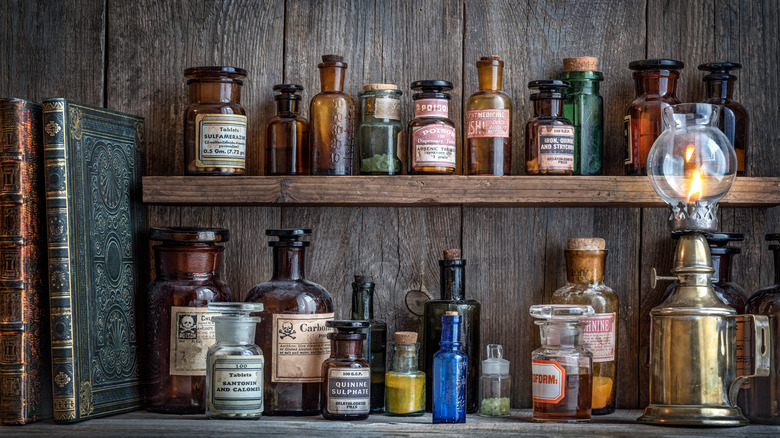The Teacup Poisoner's Unique Obsession That Led To Murder
In a manner akin to some nightmarish descent into Wonderland, Graham Young, who lived from 1944 to 1990, developed a malicious reputation for secretly poisoning people around him — including friends and family members — with different chemicals and ultimately ended up committing murder before he even entered adulthood. In 1962 his stepmother would become the first to perish as a result of his twisted and inconspicuous methods, per Biography.
But first, he experimented. In 1961, after serving his sister a cup of tea laced with toxic substances that made her severely sick, the 14-year-old Young became the focal point of suspicion from both his family and local authorities. The sister didn't die, but the families' apprehensions and heightened oversight methods weren't enough to impede his demented antics, and several individuals would end up losing their lives as a result (via The Lineup).
It wasn't until around six months later that Graham Young would finally end up claiming his first victim. His stepmother, Molly Young, had become one of his prime test subjects, and after growing tired of sneaking her low doses of poisons, he decided to take the fatal final step that would initiate her demise. On April 21, 1962, Graham slipped Molly a lethal dose of thallium. She died later that night in a hospital bed with her husband and stepchildren — one of whom was responsible for her terminal state — close by her side. Thus began the treacherous and obscene saga of Graham Young, Great Britain's Teacup Poisoner.
Graham Young's obsession with poison
In the midst of a deeply troubled childhood (his mother died when he was only a baby and he spent the first two years of his life with his aunt) that mentally and emotionally ostracized him from his peers, Graham Young sought company in a series of different activities that he found more enticing than any prospective friendships he may have developed. His prime fascination resided within the field of science – chemistry in particular — and he started collecting toxic chemicals that he could experiment with and observe the effects of on people — who quickly became his preferred test subjects (per All That's Interesting).
By means of augmenting his son's seemingly harmless (and even promising) infatuation with chemicals and science, Fred Young gifted him with a personal chemistry set that he fell madly in love with and used in order to start constructing his own little apothecary of horrors. At the mere age of 13, Graham even convinced several local chemists that he was actually 17 years old and needed samples from their chemical arsenal to perform professional experiments in the realm of toxicology; it seemed as though he had a knack for poisoning people's minds as well as their bodies. With arsenic, thallium, and various heavy metals, Young started poisoning one of his schoolmates, Christopher Williams, who almost died from unknowingly ingesting his friend's concoctions. Graham Young's own family would be next to suffer his sadistic curiosities (via Biography).
Graham Young's first arrest and subsequent incarceration
Before a proper autopsy could be performed, Molly Young's body was cremated, so any chemical traces of thallium that could have been linked back to Graham were destroyed entirely. However, as months followed, Fred Young started experiencing intense stomach pains and bouts of nausea that ultimately landed him in the hospital (it was later determined that Graham had poisoned him with antimony), which refurbished old suspicions regarding possible foul play by his son. Eventually, Graham's own chemistry teacher caught on to the disturbing pattern of events that all seemed to lead back to his promising young pupil, and after finding a plethora of different poisons and literature on the subject of toxicology hidden away in Graham's desk at school, he immediately reached out to police (per Biography).
After extracting a confession out of Graham, police sent him to Broadmoor psychiatric hospital in May of 1962 where he underwent intensive therapy geared toward revitalizing his sanity. Despite his inhuman disposition for cruelty and barbaric experimentation tactics, Young was released in 1971 after experts and hospital personnel categorically proclaimed that he was cured and no longer posed a threat to society. Tragically, their assessment turned out to be totally erroneous, and as soon as he was free, Graham Young devoted himself to poisoning people with explicitly homicidal intentions, remarking to a nurse before his release that he planned to kill one person for every year he had been locked away (via All That's Interesting).
The Teacup Poisoner kills again
Even during his time at Broadmoor, Graham Young's penchant for poisoning people failed to recess. Shortly after he arrived in 1962, fellow inmate John Berridge was found dead after ingesting cyanide. Officials resolved that it was a suicide, but Young asserted that he was responsible for Berridge's death. Upon release, he became determined to take more lives using formulas he'd cooked up, and when it was all over, nobody would question whether or not he was in fact responsible (per Biography).
In 1971, following his release, Graham Young found work at a photographic supply firm called John Hadland Laboratories. The facility granted him access to an abundance of different chemicals including thallium (the substance he used to kill Molly Young years earlier). In a sick gesture of backhanded hospitality, Young regularly offered to prepare coffee and tea for his coworkers, and when a large group of them started falling ill, they were stumped as to what was causing their collective malady. They had no idea that their friendly new peer was in fact poisoning them, and before the year was out, Bob Egle (Young's boss, age 59) would die from apparent poisoning (via All That's Interesting).
Only two months after Egle's death, fellow JHL employee Fred Biggs started experiencing similar symptoms as his late work friend. He would meet the same fate on November 19, 1971. Two dead bodies later and unable to ascertain the cause, Young's coworkers were in a frenzied panic (per Biography).
Graham Young is finally caught
Like many other killers, Graham Young became the architect of his own downfall. He suggested to higher-ups at John Hadland Laboratories that thallium poisoning could have been the catalyst behind the deaths of Bob Egle and Fred Biggs. Perplexed by Young's expertise and awareness of thallium and the effects of other poisons on the human body, JHL's doctor on-site contacted the police. When authorities exhumed Young's disturbing criminal record and sick tendency to poison people, the former Broadmoor inmate was promptly arrested on November 21, 1971 (just two days after Fred Biggs passed away) and sent to jail to await trial, according to Biography.
The media had taken to calling Graham Young "The Teacup Poisoner" because of his predilection for poisoning the tea of his victims, and on June 19th of 1972, he stood before judge and jury. He was deemed guilty by the court and convicted for his atrocities. Four life sentences constituted the judge's verdict and Graham Young, the infamous Teacup Poisoner, lived out the rest of his days behind bars at Parkhurst Prison in Great Britain (via Sun Signs). On August 1, 1990, Young died at the age of 42. The cause was listed as heart failure, per Biography.




